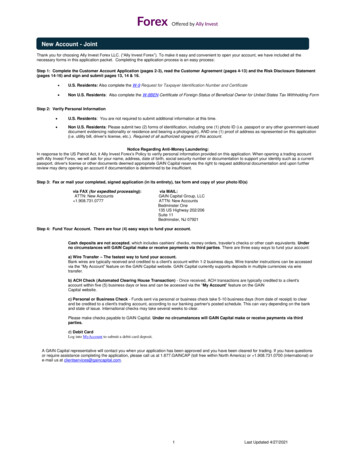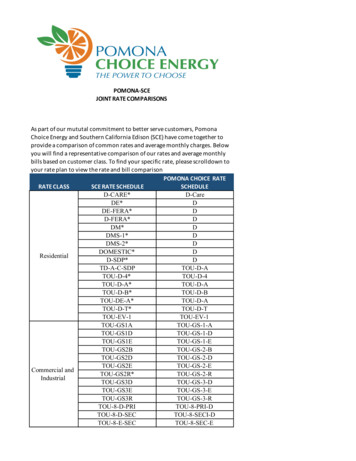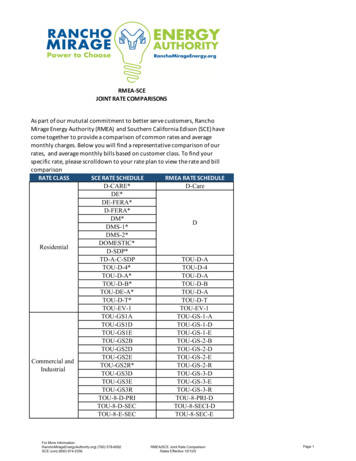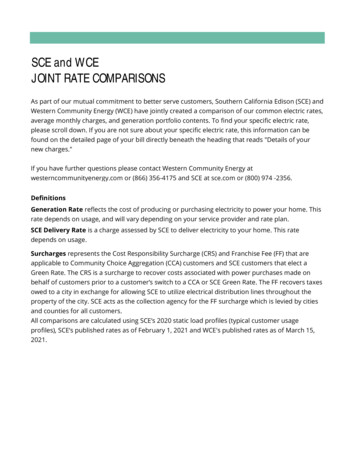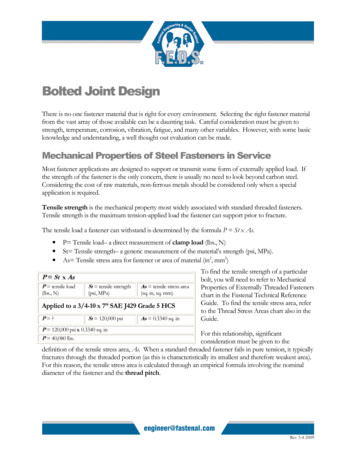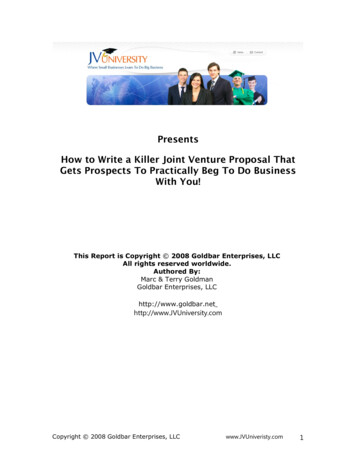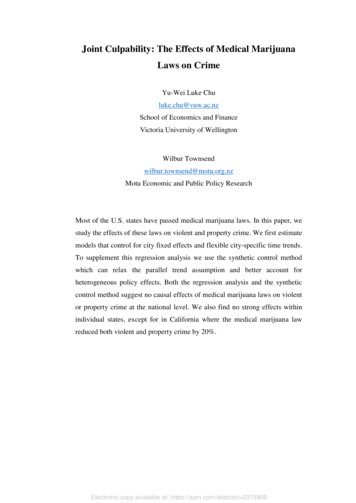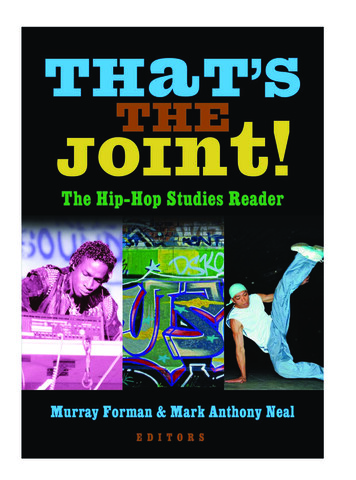
Transcription
THaT’STHEJOInt!
RT9190 C00a i-xvi8/5/043:20 PMPage ii
THaT’STHEJOInt!The Hip-Hop Studies ReaderMurray Forman & Mark Anthony NealEDITORSROUTLEDGENew York London
RT9190 C00a i-xvi8/5/043:20 PMPage ivPublished in 2004 byRoutledge270 Madison AvenueNew York, NY 10016www.routledge-ny.comPublished in Great Britain byRoutledge2 Park SquareMilton Park, AbingdonOxfordshire OX14 RNwww.routledge.co.ukRoutledge is an imprint of the Taylor & Francis Group. 2004 by Taylor & Francis Books, Inc.Printed in the United States of America on acid free paper.Typesetting: Jack Donner, BookType.All rights reserved. No part of this book may be reprinted or reproduced or utilized in anyform or by any electronic, mechanical or other means, now known or hereafter invented,including photocopying and recording or in any information storage or retrieval system,without permission in writing from the publishers.10 9 8 7 6 5 4 3 2 1Library of Congress Cataloging-in-Publication DataThat's the joint! : the hip-hop studies reader / edited by Mark Anthony Neal and Murray Forman.p. cm.Includes bibliographical references and index.ISBN 0-415-96918-2 (hardback : alk. paper) — ISBN 0-415-96919-0 (pbk. : alk. paper)1. Rap (Music)—History and criticism. 2. Rap (Music)—Social aspects. 3. Hip-hop.I. Neal, Mark Anthony. II. Forman, Murray, 1959ML3531.T43 2004782.421649'09—dc222004015140
RT9190 C00a i-xvi8/5/043:20 PMPage vDedicated to the memory ofJason “Jam Master Jay” Mizzel,R.I.P.
RT9190 C00a i-xvi8/5/043:20 PMPage vi
RT9190 C00a i-xvi8/5/043:20 PMPage 1MURRAY FORMANPart IHip-Hop Ya Don’t Stop:Hip-Hop History and Historiography9MURRAY FORMAN1Breaking13SALLY BANES2The Politics of Graffiti21CRAIG CASTLEMAN3Breaking: The History31MICHAEL HOLMAN4B-Beats Bombarding Bronx: Mobile DJ Starts Somethingwith Oldie R&B Disks41ROBERT FORD, JR.5Jive Talking N.Y. DJs Rapping Away in Black Discos43ROBERT FORD, JR.6Hip-Hop’s Founding Fathers Speak the TruthNELSON GEORGEvii45
RT9190 C00a i-xvi8/5/043:20 PMPage viiiviii CONTENTSPart IINo Time for Fake Niggas: Hip-Hop Cultureand the Authenticity Debates57MARK ANTHONY NEAL7The Culture of Hip-Hop61MICHAEL ERIC DYSON8Puerto Rocks: Rap, Roots, and Amnesia69JUAN FLORES9It’s a Family Affair87PAUL GILROY10Hip-Hop Chicano: A Separate but Parallel Story95RAEGAN KELLY11On the Question of Nigga Authenticity105R.A.T. JUDY12Looking for the “Real” Nigga: Social Scientists Construct the Ghetto119ROBIN D.G. KELLEY13About a Salary or Reality?—Rap’s Recurrent Conflict137ALAN LIGHT14The Rap on Rap: The “Black Music” that Isn’t Either147DAVID SAMUELSPart IIIAin’t No Love in the Heart of the City:Hip-Hop, Space, and Place155MURRAY FORMAN15Black Empires, White Desires:The Spatial Politics of Identity in the Age of Hip-Hop159DAVARIAN L. BALDWIN16Hip-Hop am Main, Rappin’ on the Tyne: Hip-Hop Culture as aLocal Construct in Two European Cities177ANDY BENNETT17“Represent”: Race, Space, and Place in Rap Music201MURRAY FORMAN18Rap and Hip-Hop: The New York Connection223DICK HEBDIGE19Uptown ThrowdownDAVID TOOP233
RT9190 C00a i-xvi8/5/043:20 PMPage ixCONTENTS ixPart IVI’ll Be Nina Simone Defecating on Your Microphone:Hip-Hop and Gender247MARK ANTHONY NEAL20Translating Double-Dutch to Hip-Hop:The Musical Vernacular of Black Girls’ Play251KYRA D. GAUNT21Empowering Self, Making Choices, Creating Spaces:Black Female Identity via Rap Music Performance265CHERYL L. KEYES22Hip-Hop Feminist277JOAN MORGAN23Seeds and Legacies: Tapping the Potential in Hip-Hop283GWENDOLYN D. POUGH24Never Trust a Big Butt and a Smile291TRICIA ROSEPart VThe Message: Rap, Politics, and Resistance307MARK ANTHONY NEAL25Organizing the Hip-Hop Generation311ANGELA ARDS26Check Yo Self Before You Wreck Yo Self:The Death of Politics in Rap Music and Popular Culture325TODD BOYD27The Challenge of Rap Music from Cultural Movementto Political Power341BAKARI KITWANA28Rap, Race, and Politics351CLARENCE LUSANE29Postindustrial Soul: Black Popular Music at the Crossroads363MARK ANTHONY NEALPart VILooking for the Perfect Beat:Hip-Hop Aesthetics and Technologies of Production389MURRAY FORMAN30Airshafts, Loudspeakers, and the Hip Hop Sample:Contexts and African American Musical AestheticsANDREW BARTLETT393
RT9190 C00a i-xvi8/5/043:20 PMPage xx CONTENTS31Public Enemy Confrontation407MARK DERY32Hip-Hop: From Live Performance to Mediated Narrative421GREG DIMITRIADIS33Sample This437NELSON GEORGE34“This Is a Sampling Sport”: Digital Sampling,Rap Music, and the Law in Cultural Production443THOMAS G. SCHUMACHER35Challenging Conventions in the Fine Art of Rap459RICHARD SHUSTERMAN36Hip-Hop and Black Noise: Raising Hell481RICKEY VINCENTPart VIII Used to Love H.E.R.:Hip-Hop in/and the Culture Industries493MARK ANTHONY NEAL37Commercialization of the Rap Music Youth Subculture497M. ELIZABETH BLAIR38Dance in Hip-Hop Culture505KATRINA HAZZARD-DONALD39Wendy Day, Advocate for Rappers517NORMAN KELLEY40The Business of Rap: Between the Street and the Executive Suite525KEITH NEGUS41Contracting Rap: An Interview with Carmen Ashhurst-Watson541TRICIA ROSE42Black Youth and the Ironies of Capitalism557S. CRAIG WATKINS43Homies in The ’Hood: Rap’s Commodification of Insubordination579TED SWEDENBURG44An Exploration of Spectacular Consumption:Gangsta Rap as Cultural Commodity593ERIC K. WATTSPermissions611Index615
RT9190 C00a i-xvi8/5/043:20 PMPage xiForeword“Sir, please turn around and face me,” the airport security employee directed me. As Icomplied, he continued to methodically search me at the security checkpoint. He remindedme of my son, a tall taffy-faced figure who’d barely left his youth behind. As I caught his eyeswhen he frisked my outstretched arms, he whispered to me while keeping his professionaldemeanor.“Man, I really feel your work on Pac,” he gently stated, referring to my book Holler If You HearMe: Searching for Tupac Shakur. “Plus, I’ve seen Thug Angel and Tupac Vs.”—two documentarieson the slain rapper in which I’d participated—“and you be puttin’ it down.”“May I please place my hands on your chest since my detector went off?” he quizzed memore formally without missing a beat. “Sure, no problem,” I replied. “That’s where mysuspenders are. And I’m glad you like the work.” “Fo’ sho, fo’ sho’,” he said as he effortlesslyslid back into his vernacular voice. “I’m just glad to know that somebody from your generationcares about Pac and hip-hop, and takes the time to listen to what we’re saying.”“Alright, sir, I’m finished. You’re done. But could you do me a big favor?”“What’s that?” I asked.The young man retreated to a portable booth tucked away at the end of the security lineand fetched a dog-eared paperback copy of my book. “If you don’t mind, please sign this beforeyou go.”I was moved by his heartfelt compliments. I was even more touched by his eloquent rebukeof the view that his generation is illiterate and wholly fixed on destruction and mindless materialism. We weren’t in school, and he wasn’t reading my book for a good grade or for extracredit. Like the best students, he read for passion, and for the pleasure and pursuit of criticalstimulation. It seemed that he was hungry for a sign among intellectuals and older folk that thehuge importance of hip-hop hadn’t been smothered by contempt, or just as bad, squanderedby undiscriminating enthusiasm. And his delight in me taking Tupac seriously was anunspoken nod to the fierce crosswinds in which hip-hop is presently caught. There are somewho dismiss hip-hop as the dead letter of brazen stereotype-mongering among the severelyundereducated and their gaggle of learned and over-interpreting defenders. Other critics claimthat the deficits of hip-hop are amplified because they blare beyond the borders of ugly art toinspire youth to even uglier behavior. And others protest that, stripped of politics, history, andracial conscience, hip-hop is little more than sonic pathology that blasts away all the achievement of the civil rights struggle.xi
RT9190 C00a i-xvi8/5/043:20 PMPage xiixii FOREWORDAu: “every sooften” meant?Au: Not surewhat is meantby “engage hiphop”The academic study of hip-hop— like hip-hop itself— has been the subject of complaintseven from its earliest days. By now, many of the complaints are familiar, even tired. But thathasn’t stopped their being repackaged every so often to track the sensational headlines thattrumpet the moral transgressions or violent deaths that rattle the rap world. John McWhorter,who’s made a career in the public arena by twisting anecdotes of perceived black misbehaviorinto a questionable analysis of contemporary race, eloquently weighs in with lopsided moralizing in the summer 2003 issue of City Journal. “By reinforcing the stereotypes that longhindered blacks,” McWhorter argues, “and by teaching young blacks that a thuggish adversarialstance is the properly ‘authentic’ response to a presumptively racist society, rap retards blacksuccess.” That’s an awfully big burden to carry—the fate of black success—especially for blackyouth (at least the ones who make a cameo in the anecdote that fronts McWhorter’s essay)who appear to McWhorter to embody the “antisocial behavior” encouraged by hardcore rap thatpreaches “bone-deep dislike of authority.”Many critics, including McWhorter, don’t account for the complex ways that some hip-hopartists play with stereotypes to either subvert or reverse them. For instance, amidst all the pimpmythologies and metaphors that weigh heavily on branches of contemporary hip-hop, rapperslike Common seize on pimpology’s prominence to poke fun at its pervasiveness. But its criticsoften fail to acknowledge that hip-hop is neither sociological commentary nor political criticism, though it may certainly function in these modes through its artists’ lyrics. Hip-hop isstill fundamentally an art form that traffics in hyperbole, parody, kitsch, dramatic license,double entendres, signification, and other literary and artistic conventions to get its pointsacross. By denying its musical and artistic merit, hip-hop’s critics get to have it both ways: theycan deny the legitimate artistic standing of rap while seizing on its pervasive influence as an artform to prove what a terrible affect it has on youth. There are few parallels to this heavyhanded wrong-headedness in the criticism of other art forms like films, plays, or visual art,especially when they are authored by non-blacks. These cultural products are often concededas art—even bad art, useless art, banal art, but art nonetheless—while there is a far greaterconsensus about hip-hop’s essential artlessness. That cultural bias—and unapologetic ignorance—informs many assaults on the genre that reinforce the racial gulfs that feed rap’s resentment of the status quo.Of course, not all the barbs aimed at hip-hop are meant exclusively for its artists. Some aredirected at the post-civil rights era generation of Black academics who have been prominentin practicing the academic study of hip-hop. Thus, revered intellectuals and writers like MartinKilson react angrily when they think intellectuals who engage hip-hop don’t embrace thevalues and styles of the civil rights movement. In an online journal of opinion, The BlackCommentator, Kilson points to several articles from the post-civil rights black intelligentsia toprove that they are “tossing poisoned darts at African Americans’ mainline civil rights tradition and its courageous leadership figures.” Kilson’s criticism of the post-civil rights era blackintelligentsia includes a section taking me to task for an op-ed piece I wrote for the New YorkTimes about the controversy surrounding the movie Barbershop (in which a character jokesabout such civil rights era figures as Martin Luther King, Jr. and Rosa Parks). Kilson was partof that chorus of voices decrying the movie for its perceived “irreverence toward AfricanAmerican civil rights leadership.”Kilson’s view that movies like Barbershop—as well as hip-hop more generally—“serve asanti-Black ammunition for conservative opponents of African-Americans’ civil rights agenda.”is not unrepresentative of many older—and truth to be told, younger—black folks’ beliefsabout hip-hop and those scholars associated with its defense. Many agree with Kilson that“there’s nothing whatever that’s seriously radical or progressive about hip-hop ideas and
RT9190 C00a i-xvi8/5/043:20 PMPage xiiiFOREWORD xiiivalues.” Many support Kilson’s view that hip-hop is politically empty, and is little more “thanan updated face on the old-hat, crude, anti-humanistic values of hedonism and materialism.”Critics of hip-hop like Kilson make a point, of course—and it’s not a point that’s hard tomake—that hip-hop is full of problematic expressions. It reeks of materialism; it gorges withstereotypes and offensive language; it spoils with retrogressive views; it is rife with hedonism;and it surely cannot always be said to side with humanistic values. But this argument demandslittle engagement with hip-hop; these views don’t require much beyond attending to surfacesymptoms of a culture that offers far more depth and color when it’s taken seriously and criticized in proper fashion. It is odd that gifted intellectuals should so resolutely stick to superfluous observation, as if afraid of the intellectual credibility or complex truths they might findin a comprehensive study of hip-hop. It would be outlandish to comment on, say, metaphysicalpoetry without interacting critically with its most inspired poets. At least read Donne. And ifone were to make hay over the virtues or deficits of nineteenth-century British poetry, or twentieth-century Irish poetry, then one should encounter the full range of Tennyson’s or Yeats’s workbefore jumping, or slouching, to conclusions.Unfortunately, much of the source material for such a study of hip-hop is diffuse and hardto come by. Instead of meaningful critical inquiry we argue about op-eds—and not
stance is the properly ‘authentic’ response to a presumptively racist society, rap retards black success.”That’s an awfully big burden to carry—the fate of black success—especially for black youth (at least the ones who make a cameo in the anecdote that fronts McWhorter’s essay) who appear to McWhorter to embody the “antisocial behavior”encouraged by hardcore rap that .
